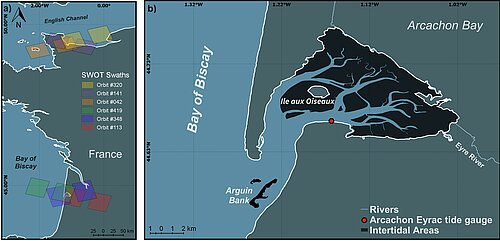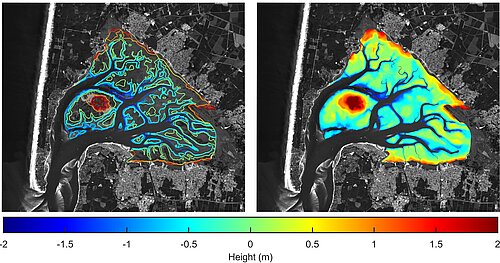Arcachon Bay between tides
Image of the Month - April 2020
Intertidal zones are complex areas to measure and monitor. Defined as the area between low and hight tide levels, they are periodically under salted water and out of it. They can also be rained on and in some cases flooded by river freshwaters. When the soil is sand or mud, it is everchanging, with banks moving all the time. The intertidal ecosystems are thus very specific and provide habitat for a large variety of biota. They are currently under high pressure with a decline of about 16% since 1980 due in particular to intertidal land reclamation. In the meantime, their environmental impact is important, especially for flood including storm surge mitigation but also navigation, fishing, etc. Monitoring their topography is thus fundamental.
The Arcachon Bay on the Atlantic coast of South-West France is a near enclosed bay with a rather narrow strait to the ocean, and a surface mostly in intertidal zone (150 km² of water surface at high tide, 40 km² at low tide). Today Synthetic Aperture Radar (such as Sentinel-1) and visible (Sentinel-2) images enable to delineate the waterline (i.e. the border between water and "land") using edge detection algorithms. With tide gauge or tide model sea level information, the elevation can be deduced along the waterlines, and a digital elevation model interpolated from those.
An digital elevation model of the intertidal area in the Arcachon Bay can be computed, but only when images are available along with tide gauges measurements, or tide model outputs. With Swot, the elevation will be retrieved directly at the same time than the image from which delineation will be done. This should lead to about 6 cm mean absolute error (a third of what is reached using SAR and visible imagery). Swot thus will have a great potential in generating intertidal DEMs and in detecting topographic changes in intertidal areas.
See also:
- Applications: High-resolution coastal applications
- Missions: Swot
References:
- Salameh, E., Frappart, F., Turki, I., & Laignel, B. (2020). Intertidal topography mapping using the waterline method from Sentinel-1 &-2 images: The examples of Arcachon and Veys Bays in France. ISPRS Journal of Photogrammetry and Remote Sensing, 163, 98-120.. https://doi.org/10.1016/j.isprsjprs.2020.03.003
- E. Salameh, B. Laignel, F. Frappart, I. Turki, D. Desroches, 2020: The use of Sentinel-1, Sentinel-2, and SWOT-type data for monitoring the topography of coastal intertidal areas, 12th Coastal Altimetry Workshop, 4-7 February 2020, ESA-ESRIN, Frascati (Rome), Italy






